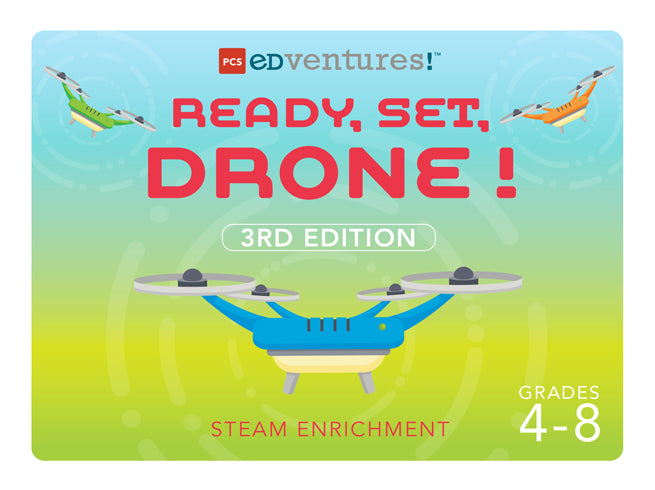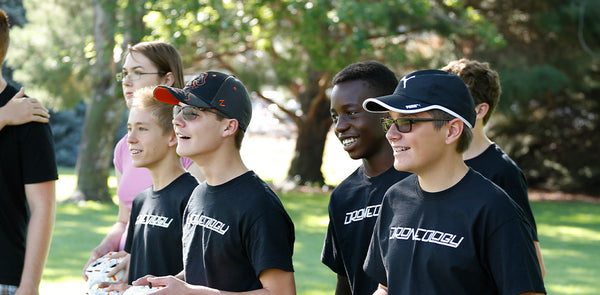
The Positive Effects of Elementary Drone Racing
There’s no denying it — the vast potential of unmanned aerial operations has whipped in-and-out of our daily lives, bringing with it vocational innovation and industry evolution. The STEM careers of tomorrow are being supercharged with the help of drones. But, the job market isn’t the only sector of our lives affected by UAVs.
Drones are taking over the World of Recreation, with drone racing quickly solidifying itself as the sport of the future. So, what is Drone Racing?

Drone racing started simply in Australia in late 2014, with pilots facing off against each other to see who could complete a course lap in the fastest time. Since then, the sport has exploded. There are leagues, ESPN races and high-octane contests held all over the world. In a race, pilots must use their quadcopter to navigate a designated course, one with air-gates and flags to fly through and around, all in an effort to shave precious seconds off of their previous lap time — all while piloting from the cockpit of the drone? Well, essentially from the cockpit. Using FPV transmitters and cameras, the pilots see what their drone sees in real time, allowing them to make pinpoint turns, flips and aerial maneuvers. With many professional UAVs reaching top speeds over 100mph, drone racing is like modern day pod racing.
But what does the world’s fastest-growing sport have to do with elementary education? Well, before we can answer that question, we need to understand how an elementary drone program works.
A Pilot’s Skill School
In any drone program, a new pilot is going to have to start with the basics. They’ll learn the hard facts of UAVs, the WHAT’s and the HOW’s.
- What is a Quadcopter
- What is First-Person View
- What are the mechanics of a drone
- How do you fly
- How do you land
- How can you practice
These hard skills are easily measurable baselines as students learn how to safely operate a drone. They give students a goal and a path towards achieving it through hard work and practice — either they can do it, or they can’t.
At its most basic level, your drone program is going to simply teach students to fly. But your drone program can be so much more than just Flyer’s Education — it can teach lifetime communication and social skills. This is where drone racing finds its foothold in elementary education.
to fly. But your drone program can be so much more than just Flyer’s Education — it can teach lifetime communication and social skills. This is where drone racing finds its foothold in elementary education.
Today’s professional pilots regularly reach speeds of over 100MPH, their drones house meticulously tuned and tested cutting-edge technology and the high-speed crashes are devastating, especially to your checkbook. But you don’t need drones to top out at 100MPH to bring drone racing to your classroom. With a downsized drone and an indoor flight course, elementary students are going to reap the rewards of the sport of the future.
With a mini drone in hand, drone racing transforms elementary STEM education by bringing a foundational aerial robotics platform to your students.
The Rigor of Racing
So, how will drone racing elevate your learning program? By allowing your students to build communication and social skills as they engage in a team sport. Apart from simply learning the mechanical, hard skills of piloting, drone racing sets your students up to grow and mature their lifelong soft skills.
Your drone program promotes hands-on, activity-based learning as a means of helping students develop the foundations of technological literacy, but by integrating drones into a team sport platform, your students are also able to freely exercise problem-solving, communication, reflection and collaboration skills — skills which, regardless of their future endeavors, are invaluable, and increasingly harder to find in today’s emerging workforce.

As students engage in the process of helping each improve their flight skills, they'll be challenged to collaborate:
- Can you come to a consensus as a group?
- Can you explain something to someone else?
- Can you listen and learn from someone else?
You’re laying the building blocks necessary for students to succeed in the quick-paced, team-based activities they will continually encounter through their scholastic and vocational careers.
Team Sports
When it comes to flying a drone, it’s hard to see how a single-player activity translates into a team-centered sport — after all, there’s only one person holding the radio controller. But, that would be like saying Rafael Nadal achieved his tennis success by himself. At the end of the day, he is the one competing at the world’s largest stage, but behind the scenes he has trainers, coaches, practice partners — even from his first match, his opponent was pushing him. There may only be one person competing, but there’s an entire team behind them to get them to that point.

To get the most out of teamwork in your drone program, your students need to freedom to interact and explore with one another. As they freely exercise their problem-solving, communication, reflection and collaboration skills, they’re not only learning about drones and drone racing, but they’re elevating the overall learning of the group they are participating in.
As Paige Maslen of Edutopia says,
Teamwork is all about collaborating with others to reach a common goal. The diverse pairing of personalities and scenarios will help your athlete become adaptable, persistent, and patient. Team sports also teach a sense of group and individual responsibility.
Being on a team with a dozen or more of your peers is an excellent way to recognize the individual talents each person brings to the table. As the Janssen Sports Leadership Center says, working with teammates teaches athletes important life skills such as to respect one another, act in unselfish ways, make good decisions on behalf of the team, and not cut corners.
Collaboration is the key, according to David and Roger Johnson. Their research shows that cooperative learning improves students’ efforts to achieve. They work harder, achieve more, remember material longer, use higher-level reasoning, and develop external and also intrinsic motivation. Students in cooperative learning situations also show increased self-esteem, and confidence in the future. They also may have an increased positive attitude towards school, grades, and their teachers.
Competition
At its heart, you cannot race without competition. There needs to be a winner, a goal to succeed — there needs to be something for students to strive for. Competition is going to be one of the strongest drone driving forces in your classroom, and it’s something you are going to use to your advantage, as long as you go about it in the right way.
Docsity, an online learning platform for students says:
Competitions play a role in motivating students to perform and excel and offer a lot more reward than just the winning prize. Competitions offer a chance for participants to gain substantial experience, showcase skills, analyze and evaluate outcomes and uncover personal aptitude. Competitions also encourage students to adopt innovative techniques and develop their ideas and skills. Very few opportunities in the average student life provide such exposure and realistic outlook towards the competitive nature of real life in such a short span of time as competitions provide. Students recurrently go through a series of brainstorming sessions, rapid problem-solving sequences and experience a totally diverse form of learning, which they usually don’t practice in their schools or colleges.
As your students are competing, they need to know that 2nd place isn’t a bad thing — they haven’t failed. The loss needs to motivate them to practice more, to achieve greater things. Mental toughness is going to differ from student to student but as long as the classroom has framed the racing challenges positively, motivation and the thrill of flight will quickly outweigh any competitive disillusion.

Now, if you do introduce drone racing, the competition in your classroom doesn’t need to be the end-all-be-all — your students aren’t fighting for the championship belt — but if used correctly, it can be the perfect motivator. An end-of-lesson race is a great way to not only thrill your students but keep interest piqued as you build upon the aerial robotics platform.
Competition is a driving force, as long as it doesn’t negatively affect your learners. It’s up to you to ensure the competition remains friendly and motivational, not detrimental.
Blending it Together
The best program for your learners is going to be the drone platform that combines the hard and soft skills required to be an exceptional drone pilot. The program needs to not only give a full education on drones and flight, but it needs to integrate communication, teamwork and social skills into the learning — it can’t be a solo project.
That’s why we designed Ready, Set, Drone! Camp as an interactive, team-based learning solution. A brand new package developed for 4th-6th grade learners, this set of 12 one-hour lessons is the perfect introduction to the world of unmanned aerial vehicles (UAVs). In this indoor camp, safety is a priority as students learn to fly in first-person view (FPV), exploring the real-world applications of drones by:
- Studying with Droneology, an online drone education platform that introduces students to drone fundamentals, safety and real-world applications
- Mastering basic piloting skills
- Constructing an obstacle course to fly through and a final race to showcase their cumulative knowledge.
Putting critical thinking to the test, the camp also has students brainstorm ways drones could be used for good, sketching out their ideas for new and innovative drones and drone uses. From the safety of classrooms and gymnasiums, Ready, Set, Drone! Is working to transform elementary STEM education by blending hard and soft skills into an interactive learning platform. On the one hand, they’re getting in-depth experience with one of the world’s fastest growing technologies, but on the other, you’re also providing them with the skills necessary to succeed in their competitive, team-based futures.










